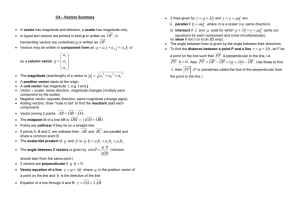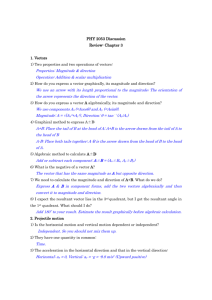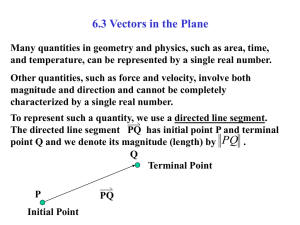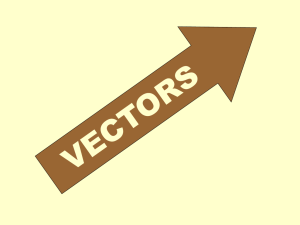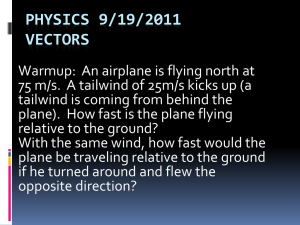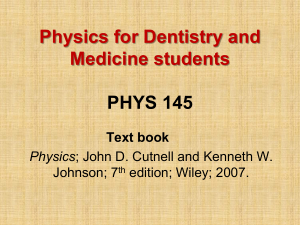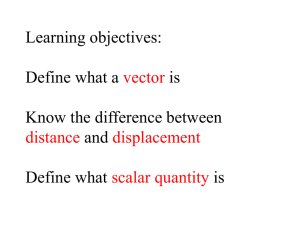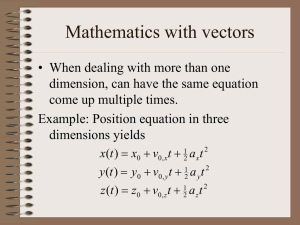In Physics - Millersville University
advertisement
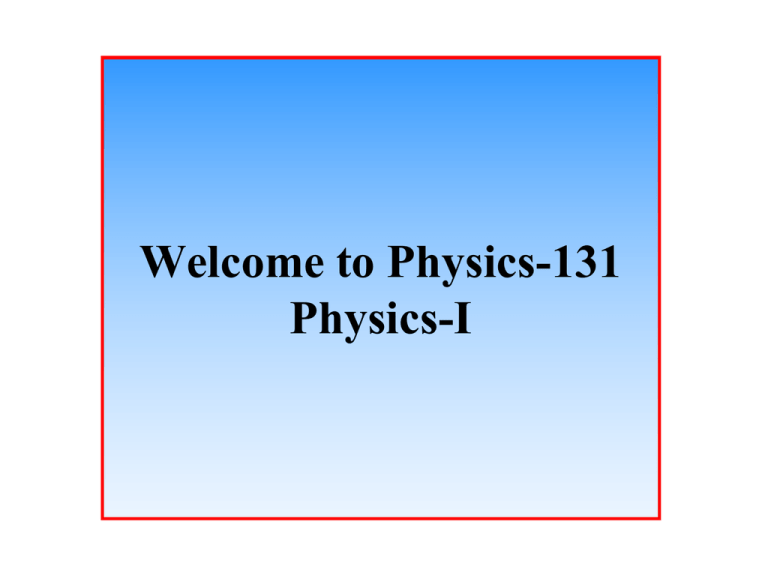
Welcome to Physics-131 Physics-I TARIQ H. GILANI ASSOCIATE PROFESSOR MILLERSVILLE UNIV. ASSISTANT PROF (2002). PENN STATE UNIVERSITY STATE COLLEGE, PA (2000) ----- POST DOC. JOHN CARROLL UNIVERSITY CLEVELAND, OH (2001) ----- VISITING ASS. PROF. PhD ---- KYOTO UNIVERSITY, JAPAN (1997). Office: R 236 (STB) Ph. 872-3291 E-mail: tariq.gilani@millersville.edu Welcome to Physics 131 Text: Physics, 9th Edition, Cutnell and Johnson Lab Notebook: Bound Lab Notebook, quad ruled, (9.75” x 7.5”). Please bring this lab notebook to your first meeting. A scientific calculator for use in Lab. Reference Books: 1. Physics, 2nd Edition, Urone. 2. Physics For Scientists and Engineers, 4th Edition, Serway. 3. University Physics, 10th Edition, Young & Freedman. Purpose It is an introductory algebra-based course. To become familiar with basic ideas of physics – Mechanics, Heat, Energy, Waves and Sound. The primary focus will be on concepts Class Lectures Discussion Problems Demonstrations Each Lab must be satisfactorily completed to pass this course Exams and Grading There will be Four in-class exams during the semester (Each Friday). In addition to the exams, laboratory and attendance will be considered. Each of these counts towards your final grade as follows: In-class exams Attendance Labs: 80% 10% 10% Tentative Dates Every Friday -------------------------- Each Lab must be satisfactorily completed to pass this course Labs You must complete all lab work. Missed Work If you miss a lab or exam for any reason, you must contact your instructor as soon as possible for arrangement. My phone # 872-3291, e-mail: tariq.gilani@millersville.edu Department office: 872-3411 (In case you have difficulty in finding me) 90-100% A 65-69.9% C+ 85-89.9% A- 60-64.9% C 80-84.9% B+ 55-59.9% C- 75-79.9% B 50-54.9% D+ 70-74.9% B- 45-49.9% D <45% F The minimum score for any grade may be lowered based on the difficulty of quiz or examination questions. Syllabus and Other Information www.millersville.edu/~tgilani What is Phys 131? Physics Mechanics Heat and Energy Waves and Sound What is Physics? Physics --- Study of basic nature of matter and the interactions that govern • • the behavior Observing and understanding the Physical world ----- Physics is most basic of all sciences. It predicts “how nature will behave in particular situation on the basis of experiments. • Space Science • Transportation Industry • Electronics and Computer Science •Medical Equipments Physics tells us the rules of the universe. In Physics • How to see the world? • Use reasoning • Apply the Physical Principles To enjoy more!! Measurements Experiments involve the measurements of quantities Measurements must be accurate, precise and reproducible First step --- defining units Research needs communication among international researchers Common Language --- System of Units How small an atom is? SI CGS BE System of measurements SI is most widely used Along with few more are base Length, Mass and Time Their units are basic units All other units are derived MKS Meter (m) Length Mass CGS centimeter (cm) Kilogram (Kg) Second (s) Time BE foot (ft) gram (g) Slug (Sl) Second (s) Second (s) Metric Units Length -------- meters (mm, cm, km,…) Mass --------- Kilograms (mg, cg, g, …) Time ---------- seconds (ns, ms, …) 1 Kg = 1000 g 1 g = 1000 mg Main Advantage Conversion within the system is quite easy • English System • Metric system 1999--- NASA’s Mars climate orbiter became a victim of confusion. Cost US$125 million SI System (International system): Three basic units of measurements Length or distance Meter (m) Mass Kilogram (kg) Time Second (s) SI System or MKS system Kilometer (km) centimeter (cm) Mega meter (Mm) Giga meter (Gm) millimeter (mm) micrometer (m) nanometer (nm) Power of 10 Example: To multiply 100,000 = 105 and 0.00001 = 10-5 102X106 = 1000 = 103 105X10-7 = 1Million = 106 1 Micro = 10-6 and so on To divide The universe is only seconds old 102/106 = A Million Trillion seconds 105/10-7 = 106X1012 = 1018s Commonly used Metric Prefixes Prefix giga mega kilo centi milli micro nano Figure = = = = = = = 1000,000,000 1000,000 1000 1/100 1/1000 1/1000,000 1/1000,000,000 Scientific Notation = 109 = 106 = 103 = 0.01 = 10-2 = 0.001 = 10-3 = 10-6 = 10-9 Words = = = = = = = 1 billion 1 million 1 thousand 1 hundredth 1 thousandth 1 millionth 1 billionth Can you tell with out using calculator? • How many inches are there in 6 miles? • How many meters are there in 6 km? How small an atom is? Pretty small 1 Million (106) atoms if put together can not be bigger than this period at the end of this sentence. •1970 --- First direct evidence of atom using SEM •1983 --- First 3-D image of an atom was obtained using STM Atoms were dragged and arranged to write the name of laboratory (IBM). Whatever system of units you use --- be consistent Can not mix ---- length in ft and mass in kg A quantity is always expressed by a number and its units (if it has) Distance --- units of length Dimensions Speed in units of length divided by units of time Dimension of Length Dimension of speed = Dimension of Time S= L T Dimension Analysis First check of mathematical relation Mathematical relation must have same dimensions on both side of the equation Example X is distance X=½vt Dimensions 2 LHS v is speed L T L =LT Relation is wrong X=½vt t is time RHS has the right dimensions T 2 Trigonometry h Sin o h Cos Adjacent ha ha h Tan ho ha h2 = ho2 + ha2 opposite ho Basic Relations Scalars and Vectors Scalar --- Quantity that need magnitude only Mass, Volume, Temperature Vector --- Quantity that need magnitude and direction Force, displacement Arrow --- direction Length --- magnitude 2 Km due East 4 Km due East Vector is represented by Boldface letter or Arrow on the symbol A or A A scalar is represented by italic symbol A vector has magnitude and direction A = 2 m due west Magnitude = 2 m A Vector Addition Magnitude and direction • When all vectors are in the same direction A = 2 m due East and B = 5 m due East Their resultant R = A + B = 7 m due East • When two vectors are pointing opposite A = 2 m East B = 5 m West => R = 3 m West • Perpendicular vectors A = 2 m East B = 5 m North West North R B East A R = [A2 + B2]1/2 Direction B A Tan 1 ( ) Degrees North of East South Graphical Method • Draw Vector A Must use same scale • Draw vector B starting at the arrow of A • R (= A + B) is from tail of A to head of B • Measure the Length and angle of R Subtraction A–B = A + (- B) Multiplying a vector with -1 => magnitude remains the same while direction is reversed A = 2m East -A = 2m west Vector Components x-component Along x-axis y-component Along y-axis A = 2 Km at 30 o North of East Ax = A cos Ay = A Sin Along x-axis Along y-axis y-axis A Ax Ay X-axis Adding by Vector components A = 2 Km 30o North of East B = 3 Km 60o North of East Ax = 2 Cos (30o) Bx = 3 Cos (60o) Ay = 2 Sin (30o) By = 3 Sin (60o) Rx = Ax + Bx Ry = Ay + By R = [R2x + R2y ]1/2 Tan ( 1 Ry Rx ) Summary • Units ---- SI System (length m, Mass Kg and Time s). • Dimensions --- First check of Mathematical relation. • Trigonometry --- Cosine, Sine and Tangent functions. • Scalar and Vector Quantities. • Scalar can be described completely by magnitude • Vector needs direction along with magnitude to be fully described. • Vector Addition and Subtraction • Graphical Method • Vector Components Method Practice • Are two vectors with the same magnitude necessarily be equal? • Conceptual Questions (FOC): 8, 15, 17 • Problem 6, 15, 37, 40, 46 and 49
